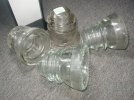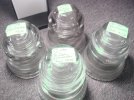I am not on HFV to "flip side" ( as you termed it ) discuss the existence of AC polarity with you.
I have been orientating AC plugs on audio gear for at least 55 years . If you do not know about this, and also refuse to take my report at face value. I can be of no help to you in any way. That is OK with me..
My friend told me today, that when he bought his brand new Conrad-Johnson PV-10 phono-line tube preamplifier, and that his Owner's Manual had a page that read like so :
" Your new PV-10 will sound different, depending upon how you plug it into the wall socket. Listen to it in both orientations, and leave it in the position that sounds best to you ".
You very obviously ( to me ) have not read or absorbed my postings in this thread.
I operate ( power dissipate ) most tubes at about only 62 percent of their MAXIMUM ratings, the Golden Ratio proportion. You may not realize this. Also, the 6N23P-EV filament is operating raised 57 VDC above ground, and my 6005 filament is 189 VDC above ground, due to the direct couple voltage, about 225 VDC, on the 6005 cathode. No excess heater to cathode problems should ever exist.
You wrote above this : " Where I come from the ability of an audio system to be "resolving" is mostly dependent on the speakers. ".
Our two personal experiences and our two audio worlds - differ dramatically from each other !!!
As I have repeated, recently and often in my thread, I believe the biggest turkeys of all in audio are not the speakers at all, but the audio amplifiers. In all of my experience, I concluded one needs a well made about 2 Watt tube amp, two stage, direct coupled, and 100 to 101 dB large radiating surface speakers. This allows the serious audio enthusiast to employ these best sounding small amps, and have the best possible overall sonic result. This has been " my " own audio course, ( non-directly ) , for most of my life.
It is not a question of me being arrogant, when I say I seek to build the world's best sounding amp, ( and that I have been TRYING to do so. ) My audio mentor, the last three decades, has that unique honor in my estimation. But I do try !!! That will put certain people off, but one must realize what my audio background actually is. Equipment I have had, many have not seen, heard, or ever owned. Lets see, nursed in 1944-45 on an ALTEC 604 field coil, then a 604B ALTEC. Outta Graduate school : brand new 15 inch Tannoy Monitor Golds, in GRF enclosures, followed by KLH 9s, single and double pairs. Quad ESL 57s, briefly. Infinity Systems Servo Stat 1s - with all 1-A panels. Fulton Premiere P 10. P-12 and P-22 model speakers, the then-widest band speaker made in audio, 12 hZ to 110 kHZ a seven way. RCA duo-cone 15s, Norelco 9710Ms on open baffles. Professional use RCA UBANGIES, three at one time, used two with MI-9449 double 15 inch woofers, and their famous WW2 era MI-1428 field coil drivers. Most audiophiles have never seen these RCA Ubangies in the flesh, nor heard them, let alone owned and used them.
Presently, I use an audio system which has been 100% gifted to me, by two local Kansas City audio friends I helped. ALTEC 515B woofers, 802D compression drivers came from one friend, and 811 Horns, 825 VOTT A7 enclosures, came from another That is right, a total A7-8 system of ALTEC , ( JUST what I would LIKE to have in a smaller apartment ) obtained for free, by mentoring / helping others.
I am not trying to brag, or be arrogant herein, I am just disclosing the facts.
And by the way, with all the unusual things that me and my mentor do when building SE amps, I really do think I " can and am " building an exceptional amplifier, with a 6005 tube, as shown to all, right in this thread. At age 77, it is about leaving a legacy of sorts. Hari Iyer has built a DC KT88 SE amp in 2020, he might carry it on !! Others may do the same. One of the three DIYers on the 6005 amp, is the same Kansas City fellow who gave me for free the ALTEC 825 ( VOTT ) horn loaded enclosures and the high frequency 811B horn !!
Re read this thread more carefully, with an open mind, but obviously, only if you care to.
P.M. ( private mail ) me through HFV, if you have any questions. I'd be very happy to communicate with you, anytime, that way, or better yet, by phone.
Jeff
PS, Here below is an old picture taken about 1978, of me picking up my ( second ) used pairs of KLH9s, from Bobby Casner, on Venice Blvd, Venice California. " Top down " !!







